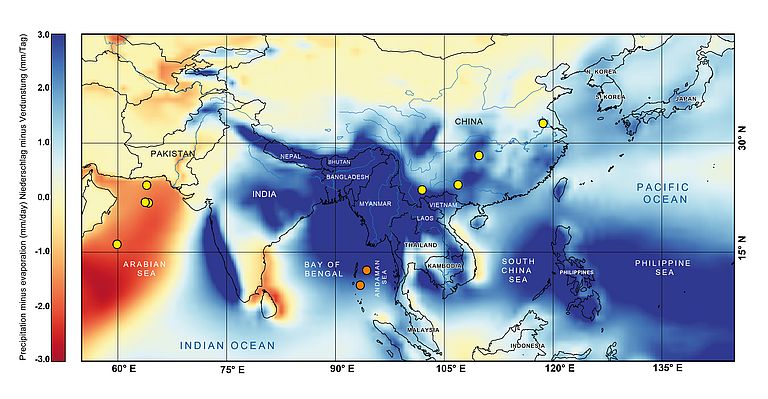One million years of precipitation history of the monsoon reconstructed
Sediment cores allow new insights into the mechanisms of this climate phenomenon
Months of heavy rainfall followed by half a year of drought - the South Asian Monsoon with its seasonally changing rainfall and wind directions has always strongly influenced the lives of people around the Indian Ocean. It is of crucial importance for agriculture and thus the food supply of several billion people. At the same time, floods and landslides in densely populated areas can be catastrophic.
But how exactly does this important climate system work? And how will it change in response to future global warming? "Even the best coupled ocean-atmosphere models still have problems to simulate the precipitation of the South Asian Monsoon," says lead author Dr. Daniel Gebregiorgis from the GEOMAR Helmholtz Centre for Ocean Research Kiel, who is now working at Georgia State University in Atlanta (Georgia, USA). Together with colleagues from Kiel and the USA, he investigated new climate archives of the history of the South Asian Monsoon, which point to connections and monsoon drivers in the southern hemisphere that have previously received little attention. The study has been published today in the international journal Nature Communications.
In its simplest form, the monsoon is driven by pressure and temperature differences between the Asian continent and the southern subtropical Indian Ocean. "The variability of the monsoon over recent geological time periods is thought to be driven by changes in solar insolation in the northern hemisphere caused by the regularly changing inclination of the Earth's axis," explains Dr. Gebregiorgis.
So far, the longer reconstruction of the monsoon history is based mainly on two climate archives: sediment cores from the Arabian Sea and stalagmites from caves in China. "The former, however, only provide information on wind conditions and not precipitation over the Indian subcontinent, while the latter has long been thought to reflect precipitation from the East Asian Monsoon. And both respond distinctly different to changes in Northern Hemisphere summer insolation on orbital timescale," explains Ed Hathorne of GEOMAR, co-author of the study.
He and his colleagues have now for the first time evaluated sediment cores from the eastern Indian Ocean that had been obtained as part of the International Ocean Discovery Program. The chemical analysis of the shells of tiny plankton that settle and are preserved on the seafloor allows the reconstruction of temperature and the amount of fresh water at the sea surface during the organisms’ lifetimes. "Using this we have been able to reconstruct precipitation in the eastern Indian Ocean for the past one million years," says Dr. Hathorne.
The new record generally shows that the precipitation of the South Asian Monsoon was weaker during the peak ice ages and strongest during the interglacial warm periods like today. "However, we were only able to associate 30 percent of the variability of monsoon precipitation in the eastern Indian Ocean with fluctuations in the Earth's axis inclination. This means that it only plays a subordinate role in the fluctuations of the monsoon," emphasizes Dr Gebregiorgis. Instead, the results of the scientists pointed to important connections with warming phases in the southern hemisphere and moisture transport across the equator to the north. "This process has hardly been considered so far," says Dr. Gebregiorgis.
"The evaluation of the new climate archives shows that we have still not fully understood the monsoon. As long as this is not the case, it is difficult to estimate the reactions of this important climate system to a globally warming atmosphere," summarizes working group leader Prof. Dr. Martin Frank from GEOMAR.
Reference:
Gebregiorgis, D., E. C. Hathorne, L. Giosan, S. Clemens, D. Nürnberg, M. Frank (2018): Southern Hemisphere forcing of South Asian monsoon precipitation over the past 1 Million years. Nature Communication, http://dx.doi.org/10.1038/s41467-018-07076-2
High-res images:
Contact:
Jan Steffen (GEOMAR, Communication and Media), Tel.:+49 0431 600-2811, presse(at)geomar.de



